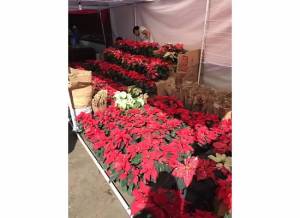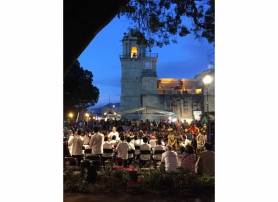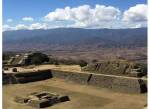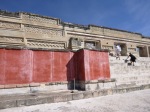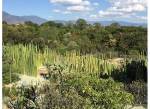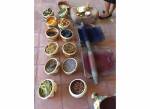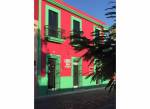Oaxaca is justly famous for its Noches de Rabanes, “Night of the Radishes,” which occurs just before December 25. Radishes—yes, radishes—are carved into crèches and other tableaus. Mind you, these are not typical radishes but an unusual variety that grows longer and narrower.
But take almost any night in the weeks leading up to Christmas in Oaxaca, and one would be likely to find a calenda (parade), Guelaguetza (folkloric dances), or posada (a procession of people seeking shelter—party–associated with “finding room at the inn”). On a single evening, a marching band fronted a group of children in costume with one representing Mary on a burro; another band with stilt walkers led the way to the cacao exhibition and tasting; and still another opened the December expo stalls on Calle M. Alcala. These 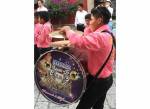
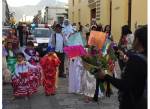 marching bands are in addition to the music on the Zocalo (town square), where almost every night about 6:00 pm, music is on the venue. On Wednesday nights, Danzon, a Cuban fusion dance that is a mix of box step and cha-cha-cha brings out old and young light—many in high fashion—to demonstrate their talents. December 18—and the two days priors—features the Virgen de la Soledad, Oaxaca’s patron saint.
marching bands are in addition to the music on the Zocalo (town square), where almost every night about 6:00 pm, music is on the venue. On Wednesday nights, Danzon, a Cuban fusion dance that is a mix of box step and cha-cha-cha brings out old and young light—many in high fashion—to demonstrate their talents. December 18—and the two days priors—features the Virgen de la Soledad, Oaxaca’s patron saint.
Another fascinating aspect of the abundance of music is the wealth of children and young people performing. Several bands featured these young artists. The Casa Cultural of Oaxaca offe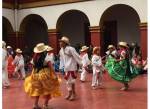 red folkloric dances on a Sunday morning with charming, colorfully dressed youngsters. This venue had free concerts almost daily. We moved from there to the San Pablo Cultural Center to listen to a brass band, while having brunch at the SP Café on its open-air second floor. By the way, the Textile Museum nearby is worth a visit.
red folkloric dances on a Sunday morning with charming, colorfully dressed youngsters. This venue had free concerts almost daily. We moved from there to the San Pablo Cultural Center to listen to a brass band, while having brunch at the SP Café on its open-air second floor. By the way, the Textile Museum nearby is worth a visit.
However the Rufino Taymao Museum was our favorite, a stellar collection of pre-Columbian artifacts chosen with an eye for their aesthetic appeal and an ethic of protecting them from export or illegal trade. Each room is color-coded and offers written guides in English—unusual for most museums in the city.
The cultural museum located in the historic cloister at the Santa Domingo Church provides artifacts re-located from the famous Zapotec ruins of Monte Alban.
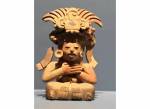 Both it and Mitla are worth the trip out of town. An accessible archaeological account is Michael Lind’s Ancient Zapotec Religion (2015), which has an excellent chapter on Mitla and its fascinating architecture. The ethnobotanical garden is adjacent to the Santa Domingo Church.
Both it and Mitla are worth the trip out of town. An accessible archaeological account is Michael Lind’s Ancient Zapotec Religion (2015), which has an excellent chapter on Mitla and its fascinating architecture. The ethnobotanical garden is adjacent to the Santa Domingo Church.
For shoppers, Oaxaca offers enormous opportunity although finding high-end interpretations of ethnic clothing is more difficult. (Somehow that colorful embroidered shirt just doesn’t look the same in Oklahoma as it did in Oaxaca. Perhaps that is why there are so many ethnic clothing items on sale at e-bay.) The historic markets at 20 November and Benito Juarez as well as the Artisan Market nearby are well worth a visit. The textiles for tablecloths and “matrimonial” covers (bed spreads) are particularly appealing. Likewise, the wool rugs that come from Teotilan del Valle can be lovely.
Prices vary according to whether one purchases from a vendor in the street (literally in the pedestrian street of Alcala after 10 pm when license police have turned in) to the tourist stores. State-run stores like ARIPO (809 Garcia Vigil) or Casa Artesanias (on Matamoros a block from Alcala) offer an overview of crafts. The women’s cooperative on Cinco de Mayo 209 also features a procession of rooms, each with a different craft. High end stores such as Voces de Copal on Alcala are also high end on prices, but the displays are much more attractive with the painted figures cunningly displayed—as opposed to being crowded by the hundreds at other locales.
Oaxaca is about music, festivals, and color, but it’s also very much about food, particularly moles, ranging from Mole Negro to Mole Verde. Tlaycudas offer a mega-quesadilla, and standard quesadillas are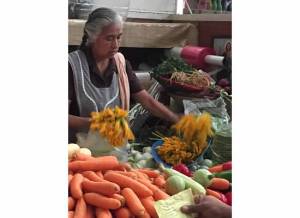 also in evidence. It’s possible to spend several hours of a day in a cooking class like those offered at Casa Crespo or at the home of famed cookbook author Susanna Trilling, author of Seasons of My Heart. Our cooking class at the former began by making tortillas from scratch—the corn, which had soaked overnight, was taken to the local grinder, and the pail of doug
also in evidence. It’s possible to spend several hours of a day in a cooking class like those offered at Casa Crespo or at the home of famed cookbook author Susanna Trilling, author of Seasons of My Heart. Our cooking class at the former began by making tortillas from scratch—the corn, which had soaked overnight, was taken to the local grinder, and the pail of doug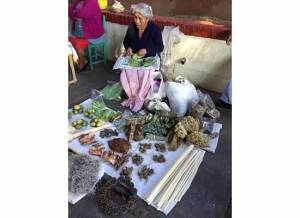 h that was returned was formed into regular tortillas and also varieties stuffed with plantain or squash blossom flowers. A trip to the market to acquire local ingredients is generally part of the class.
h that was returned was formed into regular tortillas and also varieties stuffed with plantain or squash blossom flowers. A trip to the market to acquire local ingredients is generally part of the class.
The Amante Book Store on Alcala is a good source of finding reading material although, as usual, I had stocked up prior to departure from the USA. My plane reading included Oliver Sacks charming Oaxaca Journal (2002), purportedly his report on a botanical trip he took to study ferns, but much more than that, including his observations on Oaxacan life. Oaxaca is both city and state. It’s a quick and enjoyable read.
Because I’m an English professor, I also picked up D. H. Lawrence’s Mornings in Mexico (1927), his musings about living in Oaxaca while completing his novel The Plumed Serpent (1926). Not that it’s possible to tell it’s Oaxaca from the text, which has no real details about where it is set. Lawrence wanders out on walks in the countryside, offering his opinion on their houseboy, who is torn between city and his home village. It’s an atmospheric read but not one that will appeal to many, and that includes me.
Just out in late 2015 is a fascinating graphic novel by Peter Kuper, Ruins. It follows the 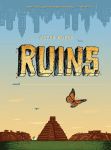 travails of George and Samantha, a New York couple taking sabbatical leave. They happen to land in Oaxaca coinciding with the infamous teacher strike of 2006, which effectively closed the city to tourists for some months and resulted in deaths of strikers and one American journalist. The couple’s story is paired with the flight of a Monarch butterfly making the journey from the USA back to the breeding grounds of Oaxaca; these scenes offer social and cultural critique that proves a picture is worth a thousand words. Kuper, a well known writer and illustrator, first published a nonfiction version of his family’s time in Oaxaca, Diario de Oaxaca. It is also worth re
travails of George and Samantha, a New York couple taking sabbatical leave. They happen to land in Oaxaca coinciding with the infamous teacher strike of 2006, which effectively closed the city to tourists for some months and resulted in deaths of strikers and one American journalist. The couple’s story is paired with the flight of a Monarch butterfly making the journey from the USA back to the breeding grounds of Oaxaca; these scenes offer social and cultural critique that proves a picture is worth a thousand words. Kuper, a well known writer and illustrator, first published a nonfiction version of his family’s time in Oaxaca, Diario de Oaxaca. It is also worth re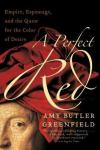 ading.
ading.
“Mexican gold” is the term given to the legendary red dye derived from the cochineal, and A Perfect Red is the fine history written by Amy Butler Greenfield that describes how Europeans sought out this import from the 16th century. It is to Mexicans what tulips were to the Dutch.
The Old Gringo (1985) by Carlos Fuentes is a terrific novel about Ambrose Bierce’s last days in Mexico, when he gets entangled with the Revolution, Pancho Villa, and General Tomas Arroyo. Bierce is the author of such acerbic works as The Devil’s Dictionary and the short story that every high school student must surely read, “An Occurrence at Owl Creek Bridge.” (Bierce has been appropriated as a detective in a series of mystery novels by Oakley Hall set in San Francisco at the 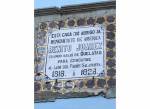 turn of the 20th century.) Oaxaca features the childhood home of Benito Juarez, the only indigenous president of the nation. Find it on Garcia Vigil near the Carmen Convent. And then have a mescal cocktail on the rooftop terrace of Mezquite nearby and watch the sun set.
turn of the 20th century.) Oaxaca features the childhood home of Benito Juarez, the only indigenous president of the nation. Find it on Garcia Vigil near the Carmen Convent. And then have a mescal cocktail on the rooftop terrace of Mezquite nearby and watch the sun set.
Noted author Richard Ford set his The Ultimate Good Luck (1987) in Oaxaca, the story of a Vietnam veteran who travels to the city to get his girlfriend’s brother out of jail. The reviews term this “a guys’ book,” and one character is called a “suavely sadistic drug dealer.” Frankly, cocaine is not the subject of a relaxing vacation read, so I gave this one a pass.
Oaxacan author Daniel Sada (1953-2011) penned Almost Never (2008) about a lonely agrarian accountant who seeks sex in a brothel and then love and marriage with a virginal girl he meets by chance at a wedding. Set in 1945, it has disconcerting notes about Hiroshima and the atom bomb. Although critically praised, it is sexually explicit and may not be everyone’s cup of tea.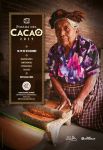
One other book we must recommend: Viva Oaxaca (2012) by Robert Adler and Jo Ann Wexler. This guidebook provided excellent advice on what to see, where to eat, and where to shop. Likewise, the Oaxaca calendar website, overseen by Margie Barclay, delivered excellent information on events, museums and gallery, and restaurants. Unfortunately, she has given  notice that she will quit early in 2016. One hopes a successor will take on this overwhelming job; otherwise, travelers may be reduced to studying the numerous posters along the streets to find out what’s on when. But then, what a good excuse for early walks around town after a breakfast that includes the city’s stunning hot chocolate.
notice that she will quit early in 2016. One hopes a successor will take on this overwhelming job; otherwise, travelers may be reduced to studying the numerous posters along the streets to find out what’s on when. But then, what a good excuse for early walks around town after a breakfast that includes the city’s stunning hot chocolate.

